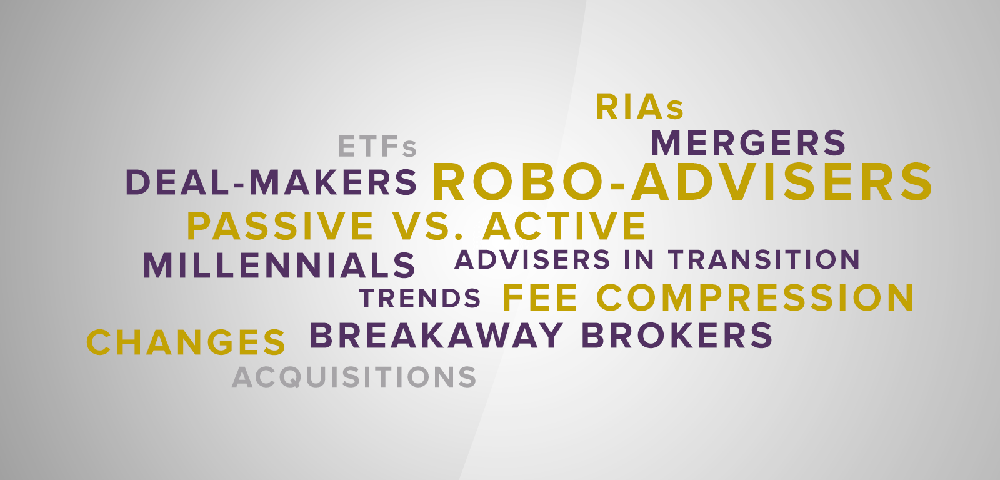In late 2014 and early 2015, many financial industry observers made projections for what might be the dominant themes impacting RIA firms in the near future. As we close in on the largest RIA-focused conference of the year, Schwab IMPACT – held in Boston in mid-November — the time is right to check in on the pulse of these issues.
1) 2015: The Year of the Robo Adviser?
Nearly every week, there is a story that hits the headlines about another major firm looking to launch their own robo-adviser (Morgan Stanley in the news on October 22) or partner with an existing platform, as Fidelity has done, teaming up with Betterment a year ago and adding LearnVest to its platform in late 2014. But, what will the lasting impact be?
Elliott Weisbluth, founder of HighTower, weighed in on robo-advisers with InvestmentNews in May saying, “They’re going to dislodge and disintermediate unskilled and mediocre financial advisers.”
Likewise, Deborah Fox, chief executive of the Fox Financial Planning Network, said, “Most advisers who don’t evolve their firms to leverage the new investment tech, as well as repricing within the next couple of years will, at best, have a hard time winning clients and, at worst, begin losing clients.”
Our take is simple. 2015 might not be the year of the robo-adviser, but it may be the year that the financial services industry finally realizes the need to digitize and revolutionize their own financial advice process and their client experience offering. Most firms on the growth track have already made investments to improve their digital offerings and recognize the need to align their perceived value with areas most difficult for robos to replace humans: advice and client relationships. We offered advice on how to do this in a post published in October of 2014.
2. Advisers on the Move.
As Josh Brown artfully outlined on his blog, The Reformed Broker, many of the crisis-era retention deals handed out by wirehouses expired this year or are about to shortly. This frees up more brokers to make their own breakaway move. At the same time, reports are in that 2015 may be the best year to date for total reported RIA transactions.
The transaction advisory firm ECHELON PARTNERS offered this to WealthManagement.com during its annual conference in September: “While two industry studies suggest an average of 46 deals per year since 2000, true volume is likely three to 10 times this amount given all the unreported deals.” This speaks to the reality that deal-making is robust and more advisers will be involved in transactions.
Amid recruitment wars M&A, and the reality that as some businesses close or divest themselves of their wealth management business, advisers will evaluate their options (see Barclays’ sale of their unit to Stifel). This creates a perfect storm where more advisers will not only be changing how they deliver financial advice, but where they do that.
Our point of view is that there will continue to be dislocations that create a flow of advisers in transition – either looking for a better platform from which they can serve their clients, or an opportunity to improve their own independence and wealth building capabilities. More than ever, the importance of social networking and the development of personal brands will help these advisers be successful in their moves.
3) ETFs Surge and AUM Fees Come Under Pressure.
There have been numerous reports that have shown the correlation of relatively low fees to better investment performance. In 2010, Morningstar released a study that looked at fees and how they corresponded with investor performance. But, as much as some pundits like to suggest, it’s not all the fault of ETFs that investors are demanding they pay less for their investments. The fact that ETFs have surged from $1.3 trillion in global AUM in 2010 to $2.97 trillion as of October 2015 can only be partially to blame for what has now become a multi-faceted attack on fees.
Forces range from the abundance of low-cost investment products that are now available, to the disruption of the 1 percent fee paradigm fostered by the robo-adviser trend. Also at play is the increased regulatory scrutiny on advisers’ compensation, all of which have worked together to challenge the profitability of the RIA business. Read the piece from Joe Duran, CEO of United Capital, published earlier this month that touches on these issues.
Duran himself forecasted this issue back in 2011 in an article with RIABiz where he said, “For advisors to survive they’ll have to work twice as hard for half of the money.”
From our perspective, we continue to hear from growth-minded RIA firms who want to adapt their own communications and brand strategy to take advantage of the opportunities presented by these sea-changing trends. They’re looking to galvanize PR campaigns and social media strategies that position their firm among those that will be winners, providing differentiated services at a premium price point. These RIA firms are hungry to have a seat at the table in merger discussions and they want to be seen as an employer of choice when newly minted college graduates or prospective career changers come calling, looking to take advantage of the opportunity in the business. And, they see the need to connect with an audience that is becoming increasingly hard to engage.
